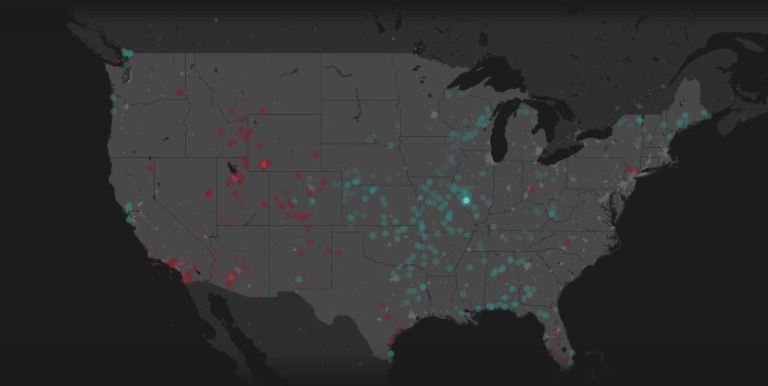University of CaliforniaFollowMay 6, 2016 · 10 min read


📷📷Emeryville, California-based Bolt Threads creates high-tech fabrics based on UC graduate research. Image: Bolt Threads
Forget the image of the startup as something hatched in a garage, spun from little more than inspiration and pizza.
In California, a growing number of startups are emerging from UC labs and research institutes — young enterprises that are changing the game in fields from health care to agriculture.
Increasingly, graduate students are the brains behind these businesses.
Every two weeks, on average, a startup forms based on a UC graduate student invention. These startups currently support 3,500 jobs, have attracted $4.1 billion in venture funding and generate $520 million in annual revenue.
Over the past decade, graduate students launched 278 new enterprises — nearly half of all UC startups to emerge in that time.
And we’re not talking about the next dating app or food delivery service. Many of these fledgling companies have the potential to revolutionize their industries, and even influence our own lives and livelihoods.
Here are 10 companies to emerge recently from UC graduate student research that are well on their way to being the next big thing:
Building a smarter stethoscope


📷📷Image: Eko Core
The time-honored doctor’s tool has changed little over the last 200 years. But it’s finally getting a high-tech upgrade with the help of Connor Landgraf, a UC Berkeley bioengineering grad student who, as someone with a chronic heart condition, has a long history with the device.
Landgraf helped create Eko Core, a device that can be attached to any stethoscope to capture a digital recording of the patient’s heartbeat, and send it to a physician’s smartphone or tablet. Doctors can then amplify, replay and view wavelengths of the heartbeat, making it easier to spot irregularities.
The device was approved by the FDA last fall and is now being marketed to physicians everywhere through Eko Core’s offices in Berkeley.
Smell good to friends, gross to mosquitoes


What if, rather than slathering yourself in potentially toxic DEET, you could arm yourself against mosquitoes with an effective, natural repellant that smelled mildly of grape and orange blossom?
SensoryGen, an Encinitas, California startup launched by UC Riverside researchers, is developing new approaches to combating mosquitoes that could offer protection from deadly diseases like Zika, dengue fever and malaria, while improving backyard barbecues everywhere.
The startup says it is two years from bringing to market a lotion made from naturally occurring plant-based compounds that is highly effective against mosquitoes, including the Aedes Aegypti that carries the Zika virus.
The product is based upon a simple idea: employ compounds that smell good to people but gross to mosquitoes.
Spider-inspired silk for “stronger than steel” clothes


At Emeryville, California startup Bolt Threads, three UC graduate school alumni are weaving material fit for a superhero: five times stronger than steel, more elastic than rubber bands, softer than wool, with applications that range from body armor to bridge supports.
The company emerged from discoveries the UC Berkeley and UC San Francisco graduate students hit upon while doing National Science Foundation-funded research into the proteins that make spider silk.
“We started with a microscopic cell — and that’s grown into a company,” said Bolt Threads CEO Dan Widmaier, who received a Ph.D. in chemistry and chemical biology from UC San Francisco.
Their patented approach, developed out of UCSF startup incubator QB3, uses genetically engineered microorganisms and a yeast fermentation process to produce a synthetic material equivalent to spider silk.
Bolt, which has raised $40 million in venture capital, says it can spin out metric tons of the stuff, while avoiding the difficulties of dealing with actual spiders — who are cannibalistic, territorial, and generally uncooperative to being farmed. The company also says its technique solves many of the technical issues that have foiled synthetic silk production thus far.
A simple urine test to detect early-stage breast cancer




Angela Courtney is a problem solver by nature — so when she was diagnosed with breast cancer shortly after starting a Ph.D. in integrative pathology at UC Davis, she took at it as her marching orders.
She dedicated her research to finding an easier way to diagnose breast cancer, especially in the early, most treatable stages. She has since developed a simple urine test that does just that.
Just as mammograms look to spot irregularities in breast tissue, her approach identifies patterns in proteins and genomic material in urine that can distinguish women who have breast cancer from those who don’t.
Courtney co-founded Adrastia Biotech, a Meadow Vista, California company that is raising money to begin clinical trials, with hopes of bringing the product to market within two years.
The test avoids many of the costs and risks associated with mammograms. And it could allow for earlier and more frequent breast cancer screens — ultimately, saving more lives.
Turning kids into computer wizards
What if we could make computer programming as fun as playing video games? That’s the idea behind ThoughtSTEM, a startup that is teaching kids to code through immersive games where they create and control virtual environments.
One of ThoughtSTEM’s signature creations is CodeSpells, a wizarding game in which kids conjure objects and spawn mystical creations, using spell books to learn the required commands. But rather than incantations like Alohomora and Stupefy!, students use programming languages such as Scratch and Alice to complete their quests.
In the course of their adventure, students master programming concepts like looping, parameters, functions and variables — skills undergraduates sometimes struggle to learn.


The company, founded by three UC San Diego graduate students, is working with more than 500 teachers in the U.S. and around the world, and has sold 40,000 coding games to kids and their parents.
In addition, the company is working directly with 30 schools in San Diego to train teachers and bring a computer programming curriculum into the classroom.
The new material that can supercharge your Tesla (or iPhone)


Imagine a power source that could charge your phone in 30 seconds and your electric car in three minutes — one that is so environmentally-friendly that it can eventually be tossed in the compost bin.
Sound too good to be true? That game-changing technology is in development by Nanotech Energy. The startup emerged from a discovery that materials scientist Maher el-Kady stumbled upon while doing his Ph.D. research at UCLA’s California NanoSystems Institute.
El-Kady was experimenting with graphene, a promising material that has proven stubbornly difficult to process. His ingenious, if low-tech solution: coat compact discs in liquid graphite, and run them through a household CD player. The player’s lasers zap the material and turn it to graphene.




📷📷Making graphene. Image: Mouser Electronics
Along the way, El-Kady noticed something curious: the laser-scribed graphene that emerged from the CD player had an uncanny ability to conduct and hold energy. After charging for just a few seconds, a tiny piece of the material could power a light for five minutes.
That’s when the lightbulb went on.
El-Kady and his colleague, UCLA faculty member Ric Kaner, realized they had stumbled onto a material with properties that the electronics industry has long desired: a power source that is both quick to charge and able to meet hefty energy demands.
From the findings, Los Angeles-based Nanotech Energy has developed graphene supercapacitors that can charge electronic devices up to 1,000 times faster than a normal battery. The company has created prototypes and is now looking to scale up production.
Putting public data at people’s fingertips


The world is awash in information. Every day, billions of pieces of public data are collected — everything from home sales and weather information, to who is visiting the White House, and what shipments are arriving from foreign ports. Some information is stored online or in local databases; some is printed on paper, and tucked away in office filing cabinets.
Together, these records offer a potential goldmine of insight and intelligence. But how to collect and make sense of it all?
That’s the job of Enigma, a startup headed by UC Irvine anthropology graduate student Marc DaCosta, which has received millions in venture funding from sources such as Comcast and The New York Times.
Pitching itself as the “Google of public data,” the company uses data crawling software — along with dozens of manually-filed Freedom of Information Act requests — to cull data from sources far and wide. It then relies on its own carefully-crafted algorithms to stitch together the myriad scraps of information into an organized series of results.
Pieced together, the data offers an extraordinary wealth of intel for anyone from a journalist looking to “follow the money” to a day-trader seeking a hot place to invest.
A groovy device for mopping up oil spills


While pursuing a Ph.D. in environmental science and management, UC Santa Barbara grad student Victoria Broje hit upon a simple idea for oil spill cleanup. By adding a grooved structure to the surface of skimming devices, she discovered she could multiply the surface area available to scoop up oil. Her device, called the Groovy Drum Skimmer, was able to soak up oil much more quickly than other devices, enabling quicker and more thorough cleanup.
Her invention couldn’t have come at a better time: Just months after it was brought to market, the Deepwater Horizon oil rig exploded, dumping billions of gallons of crude into the Gulf of Mexico.
Broje’s design was used to create a device that soaked up 4,670 gallons of oil per minute — shattering the industry standard of about 1,100 gallons per minute — helping officials cope with one of the worst environmental disasters in U.S. history.
Taking selfies to the extreme




“There are so many selfies out there, but the coolest ones are where someone is doing something crazy like a backflip off a cliff,” said UC Santa Cruz electrical engineering grad student Enes Mentese.
Cameras like GoPro have made it possible — one might say almost mandatory — for extreme sports enthusiasts like Mentese to document their exploits.
But the wakeboard and snowboard enthusiast found his quest for killer footage took a lot of the fun out of his sports — and often resulted in video that was shaky and out-of-frame.


He decided to use his engineering skills for an ambitious undertaking: creating a robotic camera with a built-in stablization system that attaches to a GoPro and can ride shotgun on the user’s bike, board or helmet.
UC Santa Cruz computer vision grad student Seongdo Kim came on board to develop the software that allows the system to track an object as it moves and changes position, refocusing as needed.
The two have launched Reflex Robotics to commercialize their device. Called the Raven, it mimics the way raptors hone in and track their quarry while flying at top speed.
“If you have to worry about a camera, your attention is divided,” said Mentese. “If you commit 100 percent to the activity while you’re filming, you can do stuff that’s more creative and pushes the sport.”
A blanket that helps preemies breathe


A heated blanket developed by UC Merced-based startup St. Vincent’s Solutions could provide comfort to new babies, but parents are the ones who will sleep easier: The blanket is designed to reduce ventilator-associated pneumonia for infants in neonatal intensive care.
Rather than wrapping the infant, the silicon blanket wraps the tubes that bring warm, humidified air to the incubator. By keeping the air within the tubes a constant temperature, the blanket reduces condensation that can be a breeding ground for infectious bacteria.
It’s a simple solution, but one with the potential to have a big impact on the hospital’s tiniest patients. Paul Barghouth, a UC Merced grad student in quantitative and systems biology, helped develop the device and has co-founded a startup to bring it to market.

Comments